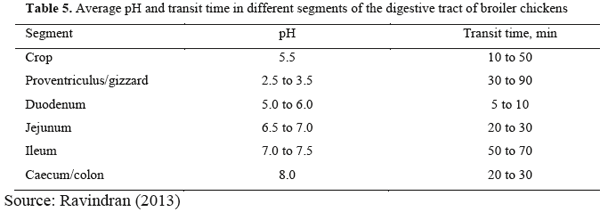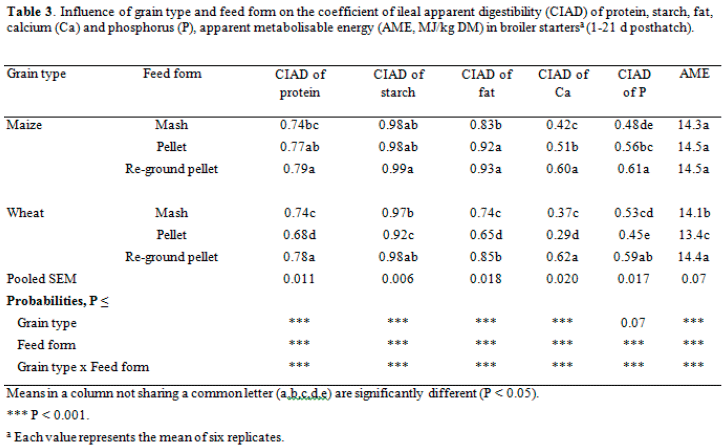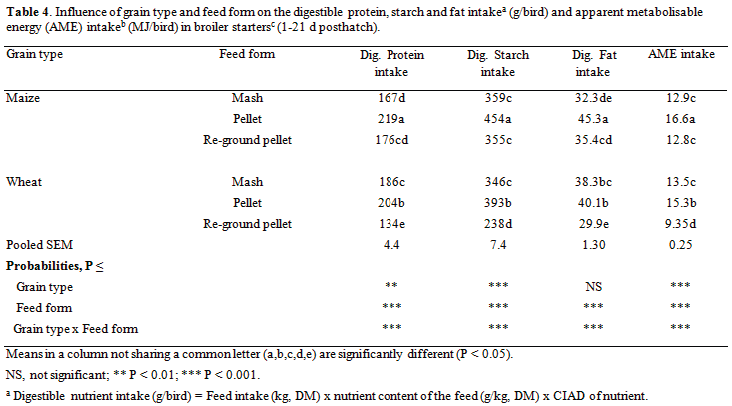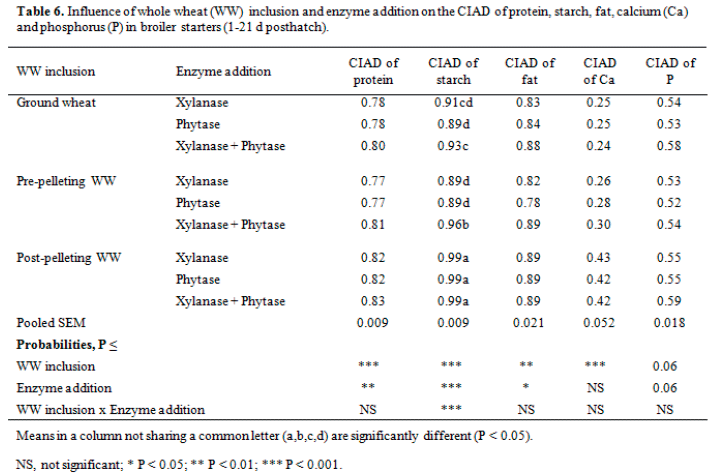Introduction
The importance of pellet feeding to broilers in improving the growth performance and feed efficiency is no longer questionable (Abdollahi et al., 2013a). On the other hand, the process of making pellets may also have detrimental effects on bird performance through chemical and physical changes that occur during pelleting. It is widely believed in the feed industry that the improved performance is due in part to increased nutrient digestibility, but there is little published evidence to support this belief. The true impact of pelleting on the utilisation of nutrients has not been clearly delineated due primarily to the pronounced effect of pelleting on broiler performance. The purpose of this paper is to provide a critical overview of the nutritional pros and cons of pelleting broiler diets.
Effect of pelleting on feed particle size
Whilst pelleting moulds mash diets to macro-particles in the form of pellets, it simultaneously reduces the size of the micro-particles that constitute the intact pellet. Svihus et al. (2004) wet sieved diets before and after pelleting and showed that the amount of coarse particles diminished and the amount of fine particles increased as a consequence of pelleting. Amerah et al. (2007) reported that pelleting reduced the relative proportion of particles > 1 mm and increased the proportion of fine particles < 0.075 mm in coarse diets. In agreement, Abdollahi et al. (2011) showed that the passage of diets through the pellet die reduced the proportion of coarse particles over 2 mm and increased the proportion of fine particles lower than 0.075 mm. These findings are in accordance with the results of Engberg et al. (2002) who reported that pelleting considerably reduced the fraction of feed particles with a size of over 1 mm from 262 to 149 g/kg in the coarsely ground diet, and from 209 to 135 g/kg in the finely ground diet. Svihus et al. (2004) speculated that, during pelleting, large particles are particularly prone to grinding due to the narrow gap between pellet rollers and the pellet die, and this may explain why the pelleting process tends to even out differences in particle size distribution. Moreover, Abdollahi et al. (2011) speculated that the frictional force inside the die hole could further grind the coarse particles to the smaller particles.
Effect of pelleting on gastrointestinal tract (GIT) development
Birds do not fully develop their digestive tract, especially the gizzard, when highly processed feeds are offered. Nir et al. (1995) reported that pelleting reduced proventriculus weight and that of its contents at 21 d of age. Pelleting also reduced gizzard weight and that of its contents at 21 and 40 d of age. A study conducted by Engberg et al. (2002) showed that pellet-fed birds had lower gizzard and pancreas weights than mash-fed birds. These researchers also reported higher pancreatic activities for amylase, lipase, and chymotrypsin in mash-fed birds compared to pellet-fed birds. Amerah et al. (2007) reported that relative empty weight of gut segments were greater in birds fed wheat-based mash diets than those fed pelleted diets. These researchers also reported greater mucosal content, villus height and crypt depth in both duodenum and jejunum in pellet-fed birds compared to mash-fed birds. This observation was considered as a general response of the digestive and absorptive capacity of the proximal small intestine to the greater load of nutrients caused by pellet feeding. Abdollahi et al. (2011) showed that pelleting reduced the relative length of small intestine and caeca. It was speculated that the changes in the length of small intestine and caeca might be due to nutrient digestibility changes caused by chemical and physical alterations in the diet. These researchers also observed lower weights of proventriculus, gizzard, small intestine and caeca in pellet-fed birds than those fed mash diets (Table 1).

As reviewed by Svihus (2011), the underlying cause for the simulating effects of particle size on gizzard development is the presence of structural components. According to Svihus (2011), the increase in the size of gizzard is a logical consequence of an increased need for particle size reduction, as the increased grinding activity of gizzard increases the size of gizzard muscles. A mash diet, in particular one that is coarsely ground, tends to remain longer in the gizzard, thus increasing the mechanical stimulation of this organ (Hetland and Svihus, 2001). It has been suggested that pelleting decreases the grinding requirement of the gizzard so that its function is reduced to that of a transit organ (Amerah et al., 2007). An active and more developed gizzard can regulate feed intake and prevents overconsumption of feed by birds (Svihus, 2011). Increased retention time in the gizzard as a consequence of increased gizzard volume may increase nutrient digestibility through providing more time for the secretion of hydrochloric acid and possibly pepsin, and by increasing intestinal refluxes that serve to re-expose the digesta to pepsin. Increased retention time may also potentially improve efficacy of exogenous enzymes through facilitating the mixing of the feed with added enzymes (Gonzalez-Alvarado et al., 2008). Thus, the pelleting process, due to its particle sizereducing property, may negatively influence gizzard development in broilers.
Effect of pelleting on nutrient digestibility
It is widely believed that pelleting improves nutrient digestibility. There is, however, little published evidence to support this belief. On the contrary, some reports suggest that pelleting may decrease nutrient utilisation under some conditions (Svihus, 2001).
Effects of pelleting on starch digestibility
Under processing conditions involving heat and moisture, starches gelatinise and help bind feed particles together. Gelatinisation also increases the access of starch to enzymatic degradation and this is expected to increase starch digestibility in pelleted diets. The extent of starch gelatinisation that occurs during short-term conditioning and pelleting, however, is generally small and is of minor importance (Svihus et al., 2004; Zimonja et al., 2008). Svihus (2001) reported that high starch digestibility usually coincides with mash feeding, whereas low starch digestibility is associated with feeding cold-pelleted diets. In this study, apparent ileal starch digestibility coefficients of cold-pelleted diets containing high levels of wheat were less than 0.83. It was suggested that starch digestibility of wheat-based diets is negatively correlated with feed intake. Based on significant increases in starch digestibility when a wheat-based diet was diluted with cellulose, Svihus and Hetland (2001) speculated that an overload of wheat starch in the small intestine, due to feed over-consumption, is the major cause of low starch digestibility associated with pellet feeding. Significant decreases in starch digestibility of wheat-based diets for broilers, from 0.96 in mash diets to 0.84 and 0.83 in diets pelleted at 60 and 90 ºC, respectively, due to pelleting have been reported by Abdollahi et al. (2011; Table 2). In contrast, Selle et al. (2012) found that pelleting had no effect on the ileal starch digestibility of sorghum-based diets (Table 2). These data, though limited, suggest that pelleting is not beneficial for starch digestibility and may even decrease starch digestibility as a result of high feed intake, at least in wheat-based diets.
Effects of pelleting on protein digestibility
Limited feed-processing experiments have been conducted to assess whether proteins may become more digestible as a consequence of feed processing. Carré et al. (1991) did not find any increase in protein digestibility in broiler chickens as a result of pelleting. Duodu et al. (2002) reported that cooking (10 min at approximately 95 ºC) reduced in vitro protein digestibility of sorghum, but not of maize. The poorer protein digestibility of cooked sorghum was explained by the formation of enzyme-resistant disulphide-bonded oligomeric proteins that occur to a greater extent in sorghum than in maize. It was also suggested that pericarp components, germ, endosperm cell walls, and gelatinised starch could be possible factors limiting protein digestibility in sorghum. Abdollahi et al. (2011) reported lower protein digestibility in wheat-based pelleted diets (0.84 and 0.82 in diets pelleted at 60 and 90 ºC, respectively) compared to mash diets (0.85) (Table 2). However, Selle et al. (2012) showed that pelleting of sorghum-based diets had no effect on protein digestibility, but depressed protein retention coefficient in broilers by an average of 9.1% from 0.61 in mash diets to 0.55 in intact pellets (Table 2). The depression in protein retention was partly attributed to the pelleting inducing the formation of disulfide linkages. Based on available data, therefore, it is reasonable to assume even if pelleting influences protein digestibility, it may not be a positive effect.
Effects of pelleting on energy utilisation
It has been reported by Svihus et al. (2004) that pelleting increased the apparent metabolisable energy (AME) of wheat-based diets from 11.6 to 11.8 MJ/kg. However, the increase in AME was not associated with improvements in starch digestibility. In contrast, Amerah et al. (2007) reported negative effect of pelleting on nitrogen-corrected AME (AMEn) of a wheat-based diet. In their study, pelleting reduced the AMEn from 12.5 to 11.8 MJ/kg. Abdollahi et al. (2011) also reported a decrease in AME of wheat-based diets from 14.1 to 13.8 and 13.4 MJ/kg due to pelleting at 60 and 90 ºC, respectively (Table 2). The positive effect of pelleting on feed efficiency has been consistently observed and is due partly to the reduction in feed energy used for maintenance. McKinney and Teeter (2004) reported that pelleting of maizebased diets contributed 0.78 MJ MEn/kg diet at 100% pellets (no fines), with this value decreasing with increasing proportions of fines to pellets, but still contributing 0.32 MJ MEn/kg for 20% pellets. Similarly Skinner-Noble et al. (2005) reported a contribution of 0.63 MJ MEn/kg diet from pellets compared to a mash diet. A study by Latshaw and Moritz (2009) showed that broilers fed pellets had lower heat increment and utilised feed energy more efficiently for productive purposes than those fed mash.
Impact of pelleting on nutrient utilisation is influenced by cereal type
One of our recent studies (Abdollahi et al., 2013b) showed that the effect of feed form on coefficient of apparent ileal digestibility (CIAD) of nutrients depends on the cereal base used and the nutrient considered (Table 3). In maize-based diets, pelleting had no effect on the CIAD of protein and starch but enhanced the digestibility of fat, calcium (Ca) and phosphorus (P) compared to mash diets. According to Saunders et al. (1969), the aleurone layer of cell walls in cereals encapsulates significant amounts of nutritive components. It appears that, in maize-based diets, some nutrients such as fat, Ca and P benefit from pelleting, probably caused by the disruption of cell walls and greater accessibility of cellular contents to digestive enzymes. In wheat-based diets, pelleting decreased the ileal digestibility of all nutrients (protein, 0.68 vs. 0.74; starch, 0.92 vs. 0.97; fat, 0.65 vs. 0.74; Ca, 0.29 vs. 0.37; P, 0.45 vs. 0.53) compared to the mash diet. The findings of lower CIAD of all nutrients in the current study suggest that if feed over-consumption associated with pellet feeding influences ileal digestibility in wheat-based diets (Svihus, 2001), it would not be only limited to starch and has a major negative effect on digestibility of all nutrients.
However, support for a hypothesis that factors other than nutrient overload may also interfere with nutrient digestibility in wheat-based diets may be found by taking into consideration the fact that the digestibility of none of the nutrients in birds fed pelleted maize diets were reduced, despite the 27% more feed intake. Anti-nutritive characteristics of soluble non-starch polysaccharides (NSP), which are found in higher concentrations in wheat, may account for lower nutrient digestibility in birds fed pelleted wheat diets. A proportion of NSP of high molecular weight can be solubilised in the intestinal tract and lead to an increase in the viscosity of gut contents, thus impeding nutrient absorption (Fengler and Marquardt, 1988; Choct and Annison, 1992). Some evidence indicates that the amount of soluble NSP does not change during feed processing (Pettersson et al., 1991). However, since the molecular weight of NSP has a major impact on viscosity, the viscosity of a diet containing even a low concentration of soluble polysaccharides can be very high, if the soluble NSP are of a sufficiently high molecular weight (Izydorczyk and Biliaderis, 1992). In addition, even a moderate temperature during pelleting process, may diminish the activities of endogenous enzymes present in cereals (Silversides and Bedford, 1999) leading to increased digesta viscosity. This is, most possibly, the reason why enzyme supplementation of heat processed diets results in 3 to 4 times larger reduction in viscosity compared with enzyme addition to unprocessed diets (de Vries et al., 2012).
Findings presented in Table 3 show that, while the AME of maize-based diets was not significantly affected by feed form, AME of wheat-based mash diet decreased from 14.1 to 13.4 MJ/kg due to pelleting. The loss of 0.70 MJ AME/kg diet is of practical significance and fully explainable by observed digestibility losses of protein, starch and fat in birds fed pelleted wheat diets.
Nutrient intake of pellet-fed birds
A number of factors are considered as motivations behind the pelleting of broiler feeds. Feed intake is the primary factor driving body weight gain and an increased feed intake is the primary motivation for pelleting broiler diets. Nutrient and energy intakes calculated from some of the previously discussed data on nutrient digestibility and AME are also presented in Table 2. In general, increased feed intake resulted in higher intakes of digestible protein, digestible starch and AME, and retained more protein in pellet-fed birds compared to mashfed birds. As shown in Table 4, pellet-feeding compared to mash-feeding resulted in higher digestible intake of protein, starch and fat, and AME intake in maize-based diets; while, only increased the digestible protein and starch, and AME intakes in wheat-based diets. Whilst the higher nutrient and energy intakes in maize-based pellets were resultant of an increased feed intake and higher digestibility coefficients (fat), the higher protein and starch, and energy intakes in wheat-based pellets were achieved while having lower protein and starch digestibility and AME content than mash diets. These data highlight the importance of feed intake when broilers are fed pelleted diets, especially in wheat-based diets where higher nutrient and energy intakes are achieved despite reductions in nutrient and energy utilisation.
Perspectives
In viscous grains such as wheat, an increased soluble NSP concentration and intestinal viscosity may account for the negative effects of pelleting on nutrient digestibility. Although cell wall degrading enzymes with the ability of degrading the solubilised viscous polymers may be used to improve nutrient absorption; there will be physiological limits to achieve optimal responses (Ravindran, 2013). These limits are imposed by the pH and digesta retention time within the digestive tract. Since a range of pH is encountered along the digestive tract, it becomes the first physiological limitation for the activity and stability of enzymes. The pH of feed is typically close to neutral, the crop of the chicken is mildly acidic, the proventriculus and gizzard are acidic, and the intestine is mildly alkaline to neutral toward the distal part (Table 5).

Most exogenous enzymes have an optimum pH of between 4 and 6 (Svihus, 2011); it is, therefore, most likely that exogenous enzymes are active and degrade their substrates in the anterior digestive tract (crop, proventriculus and gizzard) before they are subjected to hydrolysis by endogenous, proteolytic enzymes (Selle and Ravindran, 2007). It has been shown that gizzard pH is relatively higher with pelleted diets when compared to mash diets (Engberg et al., 2002; Huang et al., 2006; Frikha et al., 2009), due mainly to the pH of feed (5.5 to 6.5) and higher feed intake (Svihus, 2011). Grinding effect of pelleting process by further decreasing feed particle size; can also contribute to this effect. In addition, the feed spends only a relatively short time in the digestive tract of poultry and this becomes the second physiological limitation (Table 5). The average retention time in the digestive tract, excluding the caeca, is probably around 3 to 4 h (Svihus, 2011). Of this, digesta possibly spends only 60 to 90 min in the anterior digestive tract, which gives only limited opportunity for enzyme action. This complex matrix of conditions, which determines the beneficial effects of an enzyme, becomes even more limiting when birds are fed pelleted diets. The current practice of highly processing of feed and ad libitum feeding does not support the normal functions of crop, proventriculus and gizzard, and causes abnormal digestive tract development. Under continuous feeding system, the function of the crop as a storage organ appears to be lost. Gizzard is not fully developed when feeding pelleted diets (Svihus, 2011) and a less developed gizzard serves as a transit organ rather than a grinding organ, with the implication of reduced retention time. Considering the increased feed intake (up to 27% more feed, Abdollahi et al., 2013b) and decreased gizzard size (up to 32%, Abdollahi et al., 2013b) in pellet-fed birds compared to mash-fed birds, the retention time per unit of feed becomes even shorter. According to Svihus (2011), an increased gizzard volume and thus a longer retention time will allow for more hydrochloric acid secretion, combined with a stimulative effect of gizzard activity on acid secretion. Potential approaches such as whole grain addition, either pre- or post-pelleting; to restore the functionality of crop and gizzard could partly overcome the physiological limitation of pH and retention time.
According to de Vries et al. (2012), as a result of a relatively short colon and digesta retention time in poultry, the fermentative capacity of this species is limited almost exclusively to the soluble NSP. Pettersson and Åman (1989) reported degradation of NSP before the middle of small intestine of poultry and suggested that NSP degradation mainly occurs in the crop and gizzard. Therefore, an under-developed anterior digestive tract, in particular gizzard, and rapid digesta transit in birds fed pelleted diets may further contribute to increasing the soluble NSP concentrations and intestinal viscosity, and exacerbate the negative impact on nutrient absorption in wheat-based pelleted diet. It seems reasonable that an increased retention time of feed in the gizzard may potentially improve nutrient digestibility in wheat-based diets through enhancing the soluble NSP degradation. Data from a recent study in our laboratory showed that, either post-pelleting inclusion of 250 g/kg whole wheat (WW) or pre-pelleting WW inclusion with a combination of xylanase + phytase into a wheat-based diet, improved digestibility of nutrients (unpublished study, Table 6). The data indicate that the adverse effects of pellet feeding on nutrient digestibility in wheat-based pellets can be minimised or even eliminated through combinations of techniques by which upper gut development may improve and the inclusion of NSP degrading enzymes.
References
ABDOLLAHI, M.R., RAVINDRAN, V., SVIHUS, B. (2013a) Pelleting of broiler diets: An overview with emphasis on pellet quality and nutritional value. Animal Feed Science and Technology 179: 1-23.
ABDOLLAHI, M.R., RAVINDRAN, V., SVIHUS, B. (2013b) Influence of grain type and feed form on performance, apparent metabolisable energy and ileal digestibility of nitrogen, starch, fat, calcium and phosphorus in broiler starters. Animal Feed Science and Technology 186: 193-203.
ABDOLLAHI, M.R., RAVINDRAN, V., WESTER, T.J., RAVINDRAN, G., THOMAS, D.V. (2011) Influence of feed form and conditioning temperature on performance, apparent metabolisable energy and ileal digestibility of starch and nitrogen in broiler starters fed wheat-based diet. Animal Feed Science and Technology 168: 88-99.
AMERAH, A.M., RAVINDRAN, V., LENTLE, R.G., THOMAS, D.G. (2007) Influence of feed particle size and feed form on the performance, energy utilisation, digestive tract development, and digesta parameters of broiler starters. Poultry Science 86: 2615-2623.
CARRÉ, B., BEAUFILS, E., MELCION, J.P. (1991) Evaluation of protein and starch digestibilities and energy value of pelleted or unpelleted pea-seeds from winter or spring cultivars in adult and young chickens. Journal of Agricultural and Food Chemistry 39: 468-472.
CHOCT, M., ANNISON, G. (1992) Anti-nutritive effect of wheat pentosans in broiler chickens: Roles of viscosity and gut microflora. British Poultry Science 33: 821-834.
de VRIES, S., PUSTJENS, A.M., SCHOLS, H.A., HENDRIKS, W.H., GERRITS, W.J.J. (2012) Improving digestive utilization of fiber-rich feedstuffs in pigs and poultry by processing and enzyme technologies: A review. Animal Feed Science and Technology 178: 123-138.
DUODU, K.G., NUNEST, A., DELGADILLOT, I., PARKER, M.L., MILLS, E.N.C., BELTON, P.S., TAYLOR, J.R.N. (2002) Effect of grain structure and cooking on sorghum and maize in vitro protein digestibility. Journal of Cereal Science 35: 161-174.
ENGBERG, R.M., HEDEMANN, M.S., JENSEN, B.B. (2002) The influence of grinding and pelleting of feed on the microbial composition and activity in the digestive tract of broiler chickens. British Poultry Science 43: 569-579.
FENGLER, A.I., MARQUARDT, R.R. (1988) Water-soluble pentosans from rye. 1. Isolation, partial-purification, and characterisation. Cereal Chemistry 65: 291-297.
FRIKHA, M., SAFAA, H.M., SERRANO, M.P., ARBE, X., MATEOS, G.G. (2009) Influence of the main cereal and feed form of the diet on performance and digestive tract traits of brown-egg laying pullets. Poultry Science 88: 994-1002.
GONZALEZ-ALVARADO, J.M., JIMENEZ-MORENO, E., VALENCIA, D.G., LAZARO, R., MATEOS, G.G. (2008) Effects of fibre source and heat processing of the cereal on the development and pH of the gastrointestinal tract of broilers fed diets based on corn or rice. Poultry Science 87: 1779-1795.
HETLAND, H., SVIHUS, B. (2001) Effect of oat hulls on performance, gut capacity and feed passing time in broiler chickens. British Poultry Science 42: 354-361.
HUANG, D.S., LI, D.F., XING, J.J., MA, Y.X., LI, Z.J., LV, S.Q. (2006) Effects of feed particle size and feed form on survival of Salmonella typhimurium in the alimentary tract and cecal S. typhimurium reduction in growing broilers. Poultry Science 85: 831-836.
IZYDORCZYK, M.S., BILIADERIS, C.G. (1992) Effect of molecular size on physical properties of wheat arabinoxylan. Journal of Agricultural and Food Chemistry 40: 561-568.
LATSHAW, J.D., MORITZ, J.S. (2009) The partitioning of metabolisable energy by broiler chickens. Poultry Science 88: 98-105.
McKINNEY, L.J., TEETER, R.G. (2004) Predicting effective caloric value of non-nutritive factors: ?. Pellet quality and ??. Prediction of consequential formulation dead zones. Poultry Science 83: 1165-1174.
NIR, I., HILLEL, R., PTICHI, I., SHEFET, G. (1995) Effect of particle size on performance. 3. Grinding pelleting interactions. Poultry Science 74: 771-783.
PETTERSSON, D., ÅMAN, P. (1989) Enzyme supplementation of a poultry diet containing rye and wheat. British Journal of Nutrition 62: 139-149.
PETTERSSON, D., GRAHAM, H., ÅMAN, P. (1991) The nutritive value for broiler chickens of pelleting and enzyme supplementation of a diet containing barley, wheat and rye. Animal Feed Science and Technology 33: 1-14.
RAVINDRAN, V. (2013) Feed enzymes: The science, practice, and metabolic realities. Journal of Applied Poultry Research 22: 628-636.
SAUNDERS, R.M., WALKER, H.G., KOHLER, G.O. (1969) Aleurone cells and the digestibility of wheat mill feeds. Poultry Science 48: 1497-1503.
SELLE, P. H., RAVINDRAN, V. (2007) Microbial phytase in poultry nutrition. Animal Feed Science and Technology 135: 1-41.
SELLE, P.H., LIU, S.Y., CAI, J., COWIESON, A.J. (2012) Steam-pelleting and feed form of broiler diets based on three coarsely ground sorghums influences growth performance, nutrient utilisation, starch and nitrogen digestibility. Animal Production Science 52: 842- 852.
SILVERSIDES, F.G., BEDFORD, M.R. (1999) Effect of pelleting temperature on the recovery and efficacy of a xylanase enzyme in wheat-based diets. Poultry Science 78: 1184-1190.
SKINNER-NOBLE, D.O., MCKINNEY, L.J., TEETER, R.G. (2005) Predicting effective caloric value of non-nutritive factors: III. Feed form affects broiler performance by modifying behaviour patterns. Poultry Science 84: 403-411.
SVIHUS, B. (2001) Research note: A consistent low starch digestibility observed in pelleted broiler chicken diets containing high levels of different wheat varieties. Animal Feed Science and Technology 92: 45-49. SVIHUS, B. (2011) The gizzard: Function, influence of diet structure and effects on nutrient availability. World’s Poultry Science Journal 67: 207-224.
SVIHUS, B., HETLAND, H. (2001) Ileal starch digestibility in growing broiler chickens fed on a wheat-based diet is improved by mash feeding, dilution with cellulose or whole wheat inclusion. British Poultry Science 42: 633-637.
SVIHUS, B., KLØVSTAD, K.H., PEREZ, V., ZIMONJA, O., SAHLSTROM, S., SCHULLER, R.B., JEKSRUD, W.K., PRESTLØKKEN, E. (2004) Physical and nutritional effects of pelleting of broiler chicken diets made from wheat ground to different coarsenesses by the use of roller mill and hammer mill. Animal Feed Science and Technology 117: 281-293.
ZIMONJA, O., HETLAND, H., LAZAREVIC, N., EDVARDSEN, D.H., SVIHUS, B. (2008) Effects of fibre content in pelleted wheat and oat diets on technical pellet quality and nutritional value for broiler chickens. Canadian Journal of Animal Science 88: 613-622.














.jpg&w=3840&q=75)